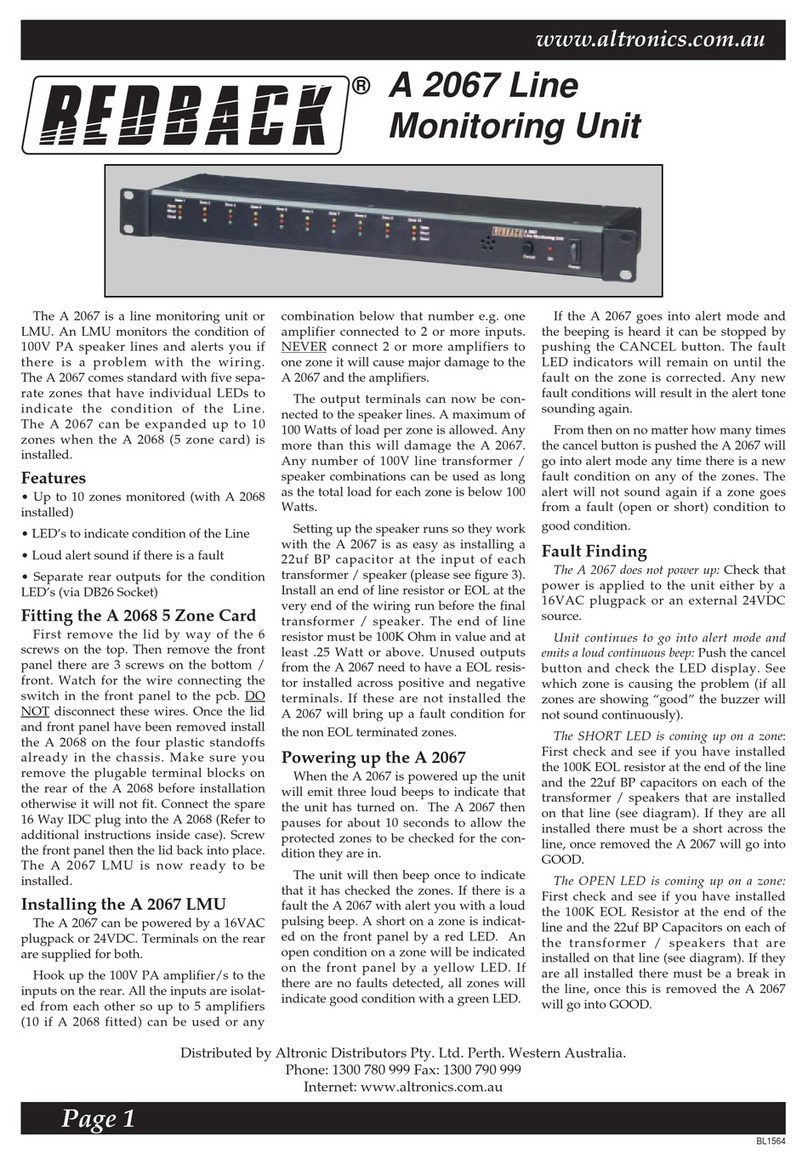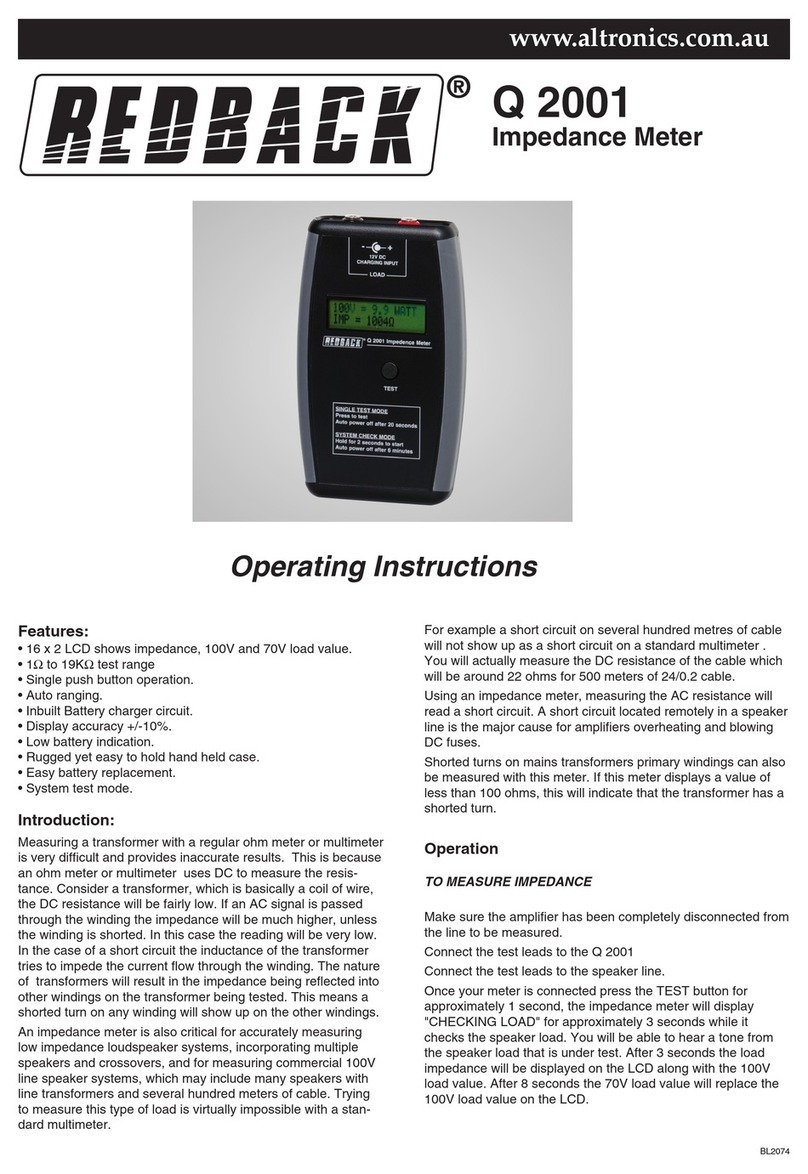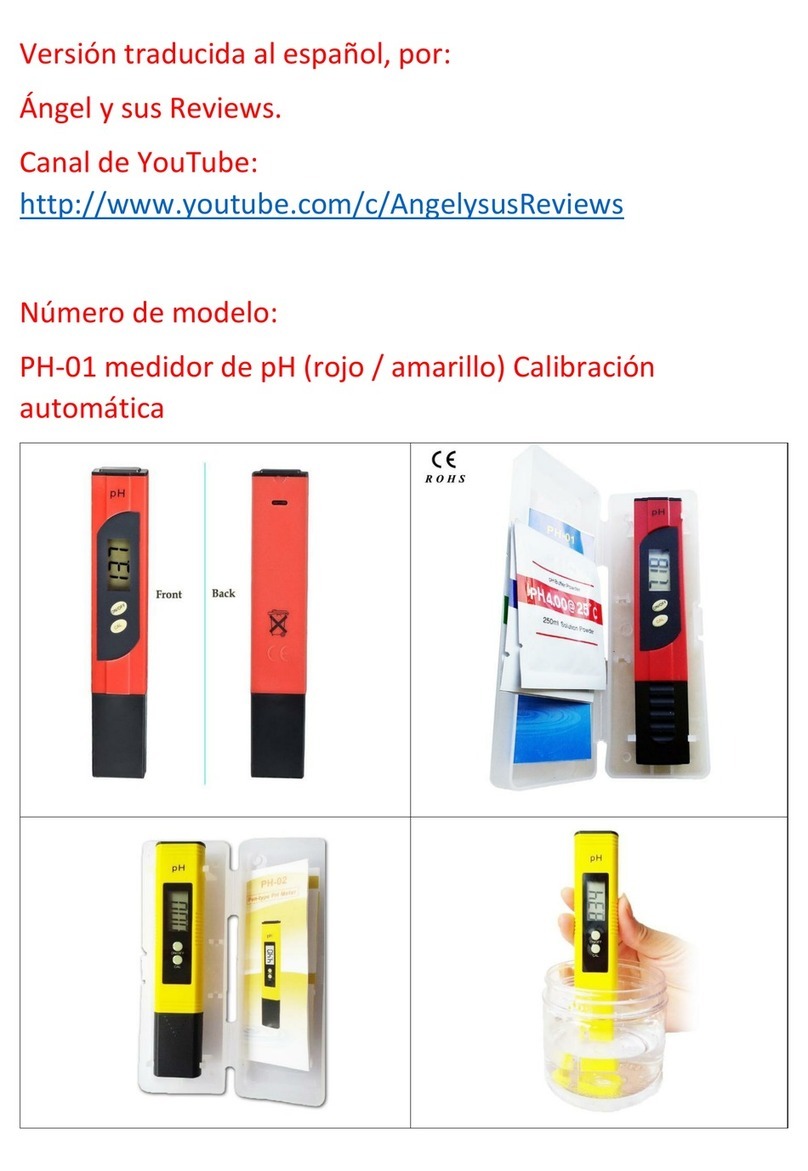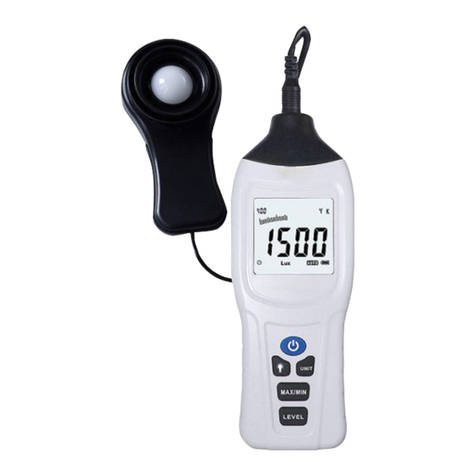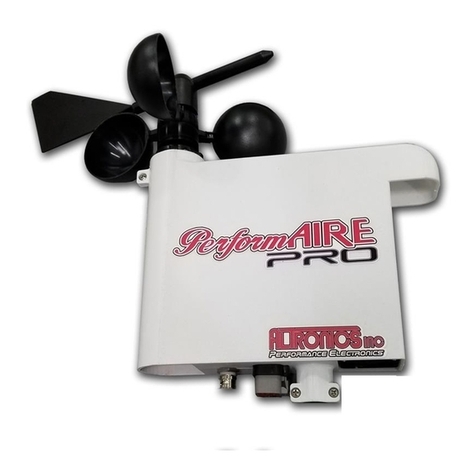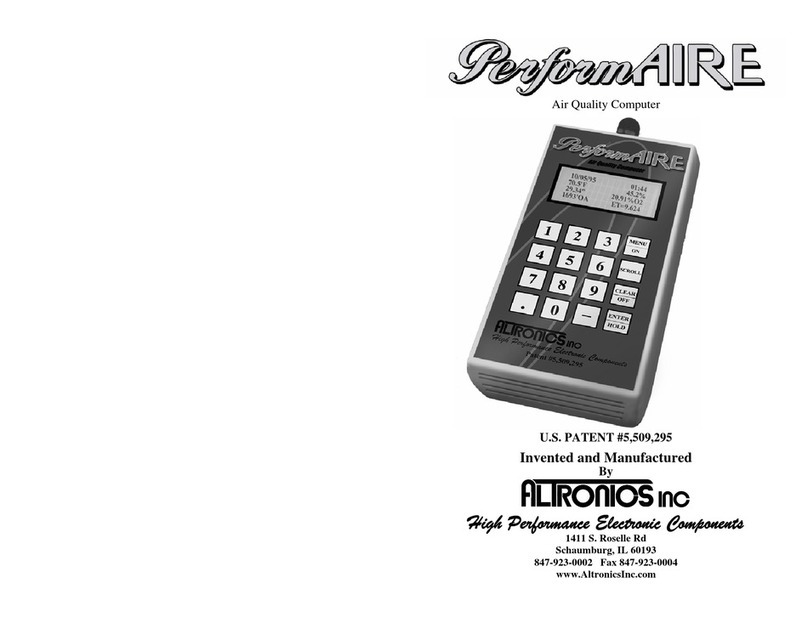
hFE
nF, μF
mV, V
uA,mA,A
%,℃,℉
NCV
MΩ,kΩ,Ω
Hz, kHz, MHz
Null.
Capacitance unit: nF, uF.
Non-contact voltage testing.
Current unit: uA, mA, A. Null: uA, mA.
Duty cycle, Degrees Celsius, Degrees Fahrenheit
Non-contact voltage testing.
Megohm, Kilohm, Ohm.
Hertz, Kilohertz, Megahertz
Low battery indication.
(9)V/Ω input terminal: Measurement inputs positive terminal (red test lead). COM
input terminal: Measurement inputs negative terminal (black test lead).
(10)Carrying belt.
4.2 DCAMEASUREMENT
(1) Press the clamp gunlock to open the clamp jaw to get
testing wire inserted in the middle and clipped
completely. To ensure measurement accuracy, please
check to ensure that the testing wire is placed in the
middle of clamp jaw. Measure one wire in one time. If
measure more than one wires in one time, the reading
will be inaccurate.
(2) Turn the rotary function switch to position. The meter is default at DCAmeasurement after
power on. Press SELECT to switch between DC measurement.
(3) When the meter is used in a strong magnetic field, the readings could be unstable or inaccurate. Press
REL to clear to zero before measurement.
NOTE:
1) The meter uses Hall component to detect current. Hall component is a sensitive component. It is
magnetic sensitive. It is also sensitive to temperature and mechanical stress. Any impact on it would
cause the changes on reading in a short time. This causes some remaining values on the DC ampere
reading when there is no current. To get accurate reading, press REL key to clear reading before
measurement, and the testing wire must be placed in the middle of the clamp jaw.
2) Press the clamp gunlock to open the clamp jaw to get testing wire inserted in the middle and clipped
completely. Ensure that the testing wire is placed in the middle of clamp jaw. Otherwise there will be
additional accuracy ±1.0% of reading. Read the measurement current value of the testing wire on the
LCD.
3) In the measurement of the DC current, if the reading is positive value, the current is top to down
(broad is top, bottom cover is down).
4) The max testing current is 800A. Exceeding the rated current for long time will damage the meter.
Follow below instructions to get more accurate DC current measurement:
①Switch off the testing wire.
②Press the clamp gunlock to open the clamp jaw to get testing wire inserted in the middle and clipped
completely. Ensure that the testing wire is placed in the middle of clamp jaw.
③When the meter reading is stabilized in the minimum value, press the RELkey to clear it.
④Switch on the testing wire. Read after clamp meter remains stable.
⑤When measuring current, to get more accurate readings, the ambient temperature must be 0 to 60℃.
4.3ACA MEASUREMENT
(1) Turn the rotary function switch to position. The meter is default at DCAmeasurement after
power on. Press SELECT to switch betweenAC measurement.
(2) Open the clamp jaw and grip one wire and get the reading directly.
To get the most precise reading, should user put the wire in the middle of the close jaw.
Note:
1. Firstly users should select the highest range, if users are not sure about the range of current under
test, and then select the proper range based on displaying value.
2. DO NOT input the current higher than the limit, or it would damage the meter.
4.4ACV MEASUREMENT
(1) Set the rotary switch to “ ” range.
(2) Turn the function swift to ACV range. Insert the black test lead into “COM”
terminal, and the red one into “V/Ω” terminal.
(3) Connect the test leads into the circuit and get the measurement value from the
LCD.
Note:
1. DO NOT input a voltage over the limit or It may cause damage to the circuit of the
meter.
2. Be careful while measuring a high voltage circuit. Do not touch the high voltage
circuit.
4.5 DCV MEASUREMENT
(1) Set the rotary switch to “ ” range.
(2) Turn the function swift to DCV range. Insert the black test lead into “COM” terminal, and the red
one into “V/Ω” terminal.
(3) Connect test leads to the test point. LCD will display polarity and voltage of the test point connected
by the red test lead.
Note:
1. DO NOT input a voltage over the limit or It may cause damage to the circuit of the meter.
2. Be careful while measuring a high voltage circuit. Do not touch the high voltage circuit.
4.6 Non-Contact Voltage Detecting
WARNING
This Function might be disturbing by different external Sources, then might be incurred a wrong alarm
reminder, test result is just for reference when using this function.
Turn Switch button to “NCV” position, the Target Circuit to be placed on the top of
Meter, Meter will shows strong and weak signals, meanwhile, Beeper will makes
“tick-tick-tick” of alarm reminder.
Note:
1. Even if there is no any indication, the voltage might still be there. Do not rely on
NCV detector as the only way to judge whether a Voltage is still existed on the Wire
lead or not.
2. Voltage detecting may be affected by power socket design, type of insulation and its
thickness and other factors.
3. Interference sources at the external environment such as flashing light, motor might cause a wrong
signal for a wrong judgement.
4.7 RESISTANCE MEASUREMENT
(1) Set the rotary switch to “ ” range and press “SELECT” to swift to “Ω” range.
(2) Insert the black lest lead into “COM” terminal and the red one into “V/Ω” terminal.
(3) Connect the test leads to the measured resistance to get the measurement value.
Note:
1. Before measuring in line resistor, make sure that the power is off and all capacitors
have discharged completely.
2. Do not apply any voltage at resistance range.
3. When input terminal is in open circuit, LCD will display “OL”.
4. If there is an “OL” displayed on the LCD, it means it is over range, switch to a higher range. When
the test leads are shorted, there would be about 1Ω stray resistance.
4.8 DIODE AND CONTINUITY TEST
(1) Set the rotary switch to “ ” range. The original state is diode measurement mode.
(2) Forward measurement: Connect red test lead to the positive polarity and the black test lead to the
cathode polarity of the diode. LCD will display the approx. value of forward voltage
drop.
(3) Backward measurement: connect red test lead to the cathode polarity and the black
test lead to positive polarity of the diode. LCD will display “OL”.
(4) The complete diode testing includes forward and backward measurement. If the
result doesn’t meet the descriptions above, it means the diode is broken.
(5) Press “SELECT” key to select the continuity measurement mode.
(6) Insert the black test lead into “COM” terminal, and the red one into “V/Ω” terminal.
(7) Connect test leads to two points of tested circuit, if the resistance is less than 50 Ω, the buzzer
sounds.
Note:
DO NOT input any voltage value at this range!
4.9 CAPACITANCE TEST
(1) Set the rotary switch to “ ” range and press “SELECT” to swift to “ ” range.
(2) Insert the black test lead into “COM” terminal, and the red one into “V/Ω” terminal.
(3) Press “REL” key to clear the reading to make the LCD displayed zero.
(4) Connect the capacitor to “COM” and “V/Ω” terminal. (Note: the red test leads is for
positive pole +). LCD displays capacitance value.
Note:
1. Don’t input voltage or current at Capacitance range.
2. In order to assure the accuracy, please press “REL” to clear the reading before testing.
3. There is only the auto range mode under the capacitance range.
4. The capacitor must be completely discharged before testing.
5. The reading of 200uF range will take more than 15 seconds to be stable.
4.10 FREQUENCY MEASUREMENT
(1) Turn the function swift to Hz range. Insert the black lest lead in “COM” terminal and
the red one in “V/Ω” terminal.
(2) Connect the test leads to the measured circuit and get the measurement value.
Note:
1. In noisy environment, it's better to use shield cable to measure a low signal.
2. When measuring high voltage circuit, do not touch the high voltage circuit.
3. Don’t input voltage higher than 250Vrms or it may damage the meter.
4.11 TEMPERATURE TEST
(1) Turn Switch button to “℃/℉”, press “SELECT/ ”key to choose ℃ or ℉
measurement mode.
(2) Insert the black plug of the thermocouple sensor into “COM” and red one into
“V/Ω” jack, and put the working terminal (temperature measuring end) of
thermocouple on the surface or inside the object to be tested. Then you can read
temperature from the screen, and the data is in Centigrade.
Note:
1. The meter should be far away high temperature. Use the thermocouple probe within
the specified temperature range.
2. Don’t change the temperature probe randomly, or the accuracy will not be guaranteed.
3. Don’t input voltage at temperature range.
4.12AUTO POWER OFF
(1) The meter will auto power off if there is not any operation in 15 minutes and come into dormant
mode. The beeper will sound five times within 1 minute before power-off.
To restart the meter, please press any function key or turn to the function swift.
(2) Press “SELECT” key and turn on the meter or press “SELECT” when the meter is in dormant mode
to wake up the meter and the “AUTO POWER OFF” function will be cancelled
5. MAINTENANCE
The meter is a precise instrument. Random changes to the circuit should be avoided.
Note:
1. DO NOT put voltage higher than 600V rms.
2. DO NOT apply voltage in current, resistance, diode and continuity range.
3. DO NOT make any measurements when the battery isn’t installed or the back cover isn’t fixed.
4. Before replacing battery or fuse, please remove the test leads from the measuring point and turn off
the power.
5. Keep the meter away from water, dust and shock.
6. DO NOT use the meter under high temperature, high humidity, combustible, explosive and strong
magnetic environments.
7. Clean the case with a damp cloth and mild detergent only. DO NOT use abrasives or alcohol or any
other strong solvents to clean the meter.
8. To avoid leakage damage, please take out the battery if the meter will not be used for a long time.
9. When “ ” symbol is displayed, you should replace the battery according to the following steps:
a) Unscrew the screw on the battery door and remove the cover.
b) Replace the old battery with a new one. (For long life, it's better to use alkaline battery.)
c) Replace the battery door and tighten the screw.
6. TROUBLE SHOOTING
If the meter does not work properly, please check the meter as following steps:
(If the problems still cannot be solved, please refer to repairing center or contact the local dealers.)
Turn on the power
Replace battery
Release the HOLD key
No current or temperature input
■The specifications are subject to changes without prior notice.
■The content of this manual is regarded as correct. If users find out any mistakes or omissions,
please kindly contact the manufacturer.
■The manufacturer will not be responsible for accidents and damage caused by improper
operations.
■The functions described in this User Manual shall not be considered as the reason for any
special usages.
EN-2016_V0.1
